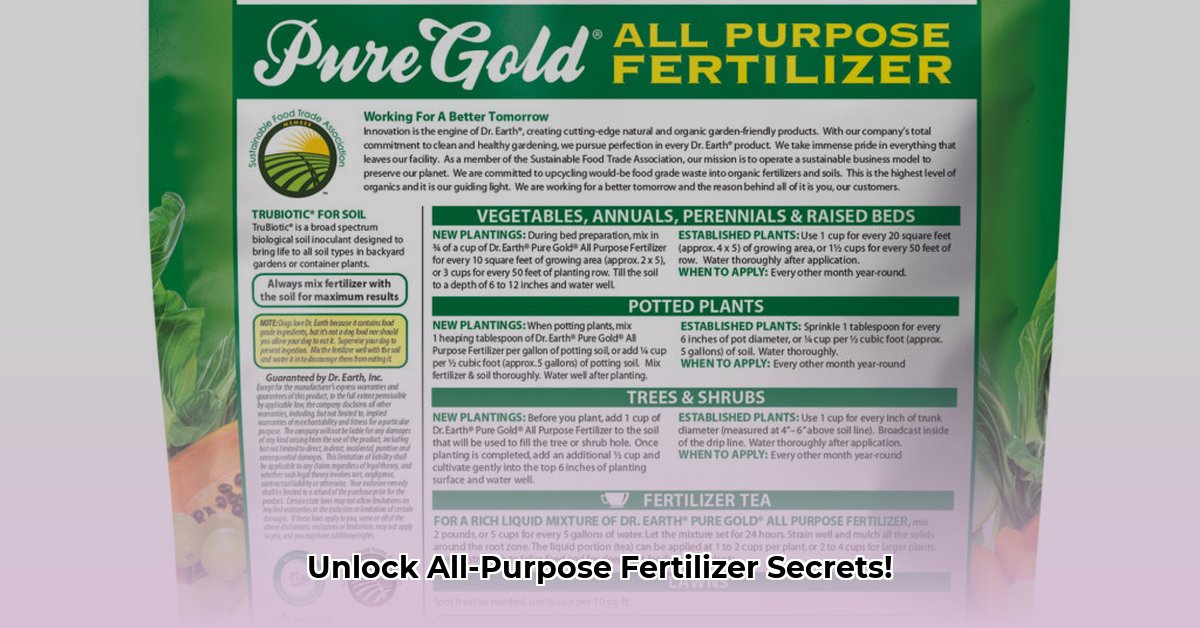Is your garden looking a little under the weather? Do your plants seem to be struggling, lacking that vibrant green and lush growth you envisioned? The secret to a thriving garden often lies beneath the surface – in the soil. And all-purpose fertilizer can be the key to unlocking your garden’s full potential. This comprehensive guide will equip you with everything you need to know about all-purpose fertilizer, from understanding what it is to using it effectively. Whether you’re a seasoned gardener or just starting out, get ready to cultivate the garden of your dreams.
Decoding All-Purpose Fertilizer
All-purpose fertilizer is essentially a balanced meal for your plants, providing the essential nutrients they need for robust growth and vibrant blooms. Think of it as a multivitamin, supplying a blend of nitrogen (N), phosphorus (P), and potassium (K) – the building blocks of plant health.
The N-P-K Ratio: Your Plant’s Nutritional Label
Those three numbers you see on fertilizer packaging (e.g., 10-10-10 or 20-20-20) represent the N-P-K ratio. This tells you the percentage of each nutrient in the mix. Nitrogen fuels leafy growth, contributing to that lush, green appearance. Phosphorus supports strong root development and encourages vibrant blooms. Potassium acts as an overall health booster, improving disease resistance and helping plants withstand environmental stress. Understanding this ratio empowers you to choose the right fertilizer for your plants’ specific needs.
Why Choose All-Purpose?
For many, especially beginners, all-purpose fertilizer offers a convenient and effective solution. It’s readily available, cost-effective, and provides a balanced nutritional foundation for a wide variety of plants. It’s a great starting point for ensuring your garden receives essential nutrients.
Types of All-Purpose Fertilizer: Finding the Right Fit
All-purpose fertilizers come in various forms, each with its own set of advantages. Selecting the right type is like choosing the best way to deliver those essential vitamins – quick boost or slow release?
Liquid Fertilizer: The Quick Fix
Liquid fertilizers are like an instant energy boost for your plants. They are fast-acting and easily absorbed, providing a rapid nutrient fix. However, this quick absorption means they may require more frequent applications.
Granular Fertilizer: Slow and Steady Wins the Race
Granular fertilizers are the time-release capsules of the plant world. They release nutrients slowly over time, providing a longer-lasting feed. While they may take a bit longer to show visible results, they offer the convenience of less frequent applications.
Organic vs. Synthetic: Nurturing Your Garden and the Planet
Organic fertilizers, derived from natural sources like compost and manure, improve soil health over time and are generally considered more environmentally friendly. Synthetic fertilizers, manufactured to deliver a concentrated dose of nutrients, offer a quick boost but may raise environmental concerns if overused.
Here’s a quick comparison:
| Type | Pros | Cons |
|---|---|---|
| Liquid | Fast-acting, readily absorbed | Requires frequent applications |
| Granular | Slow-release, long-lasting feeding | Slower to show results |
| Organic | Improves soil health, eco-friendly | Can be more expensive, slower acting |
| Synthetic | Quick nutrient boost, readily available | Potential environmental impact if overused |
Using All-Purpose Fertilizer: A Step-by-Step Guide
Using all-purpose fertilizer is straightforward, but following the product label instructions is crucial. Just like a recipe, different fertilizers have different strengths.
- Read the Label: This is non-negotiable. The label provides specific dosage and application instructions.
- Prep Your Garden: Lightly water the area before applying granular fertilizer to aid dissolution and prevent burning.
- Apply the Fertilizer: Use a spreader for even lawn coverage. For individual plants, sprinkle granules around the base, avoiding contact with stems or foliage. Dilute liquid fertilizers according to instructions.
- Water (If Needed): Some fertilizers require watering after application to facilitate nutrient absorption. Check the label for guidance.
Potential Downsides and Precautions: A Balanced Approach
While all-purpose fertilizer is beneficial, over-fertilizing can harm plants and the environment. Follow recommended application rates and store fertilizers safely away from children and pets. Some synthetic fertilizers contain chemicals that, while generally safe when used correctly, might raise environmental concerns if overused. Ongoing research explores the long-term impacts of these chemicals.
When to Use (and Not Use) All-Purpose Fertilizer: The Right Tool for the Job
All-purpose fertilizer excels at maintaining established plants, offering a general nutrient boost. However, for delicate seedlings or young plants, a gentler starter fertilizer is often preferred. Plants with specific nutrient needs, like roses or tomatoes, might benefit from targeted fertilizer blends.
Soil Testing: Getting to Know Your Garden’s Needs
Before applying any fertilizer, consider getting a soil test. This provides a detailed analysis of your soil’s nutrient levels and pH, helping you determine its specific needs and prevent over-fertilizing. Contact your local agricultural extension office or garden center for information on soil testing services in your area.
Organic Alternatives: Eco-Conscious Gardening
For those interested in organic gardening, various organic all-purpose fertilizers are available, derived from natural sources like compost and manure. Composting is another fantastic option, turning kitchen and yard waste into nutrient-rich soil amendments.
Choosing the Right All-Purpose Fertilizer
Choosing the right all-purpose fertilizer depends on your plants’ needs and your gardening preferences. Consider the NPK ratio, the type of fertilizer (liquid, granular, slow-release), and whether you prefer organic or synthetic options. Don’t hesitate to seek advice from your local garden center – they can provide valuable insights based on your specific region and plant types.
Understanding NPK Ratios: Fine-Tuning Your Plant’s Diet
NPK ratios indicate the percentage of nitrogen, phosphorus, and potassium in a fertilizer. Nitrogen fuels leafy growth, phosphorus supports root and flower development, and potassium contributes to overall plant health. Choosing the right ratio depends on the type of plants you’re growing. For example, leafy greens might benefit from a higher nitrogen ratio, while flowering plants often thrive with higher phosphorus levels. All-purpose fertilizers typically offer a balanced ratio, making them suitable for a wide range of plants.
Application Techniques: Maximizing Nutrient Uptake
Different application methods, such as broadcasting, banding, side-dressing, foliar feeding, and fertigation, offer tailored approaches to delivering nutrients. Broadcasting works well for lawns, while banding targets nutrients directly to plant roots. Foliar feeding allows for quick absorption through leaves, and fertigation efficiently delivers nutrients through irrigation water. Choosing the right method depends on your garden’s layout and your plants’ specific needs.
Troubleshooting Common Fertilizer Problems
Over-fertilizing can lead to nutrient burn, indicated by brown leaf tips. Soil pH imbalances can affect nutrient availability, even with proper fertilization. Hard water can interfere with nutrient absorption. Addressing these issues often involves soil testing, adjusting fertilization practices, and potentially amending soil or water.
By understanding the nuances of all-purpose fertilizers, you can nurture a thriving and vibrant garden. Remember, observation is key – pay attention to your plants’ responses and adjust your approach as needed. Happy gardening!
- How to Measure Your Belt Size (for Women): 3 Easy & Accurate Methods - April 27, 2025
- How to Remove Permanent Hair Dye From Hair: Safe & Effective Methods - April 27, 2025
- How to Remove Ink from Leather: Effective DIY Methods and Expert Tips - April 27, 2025










